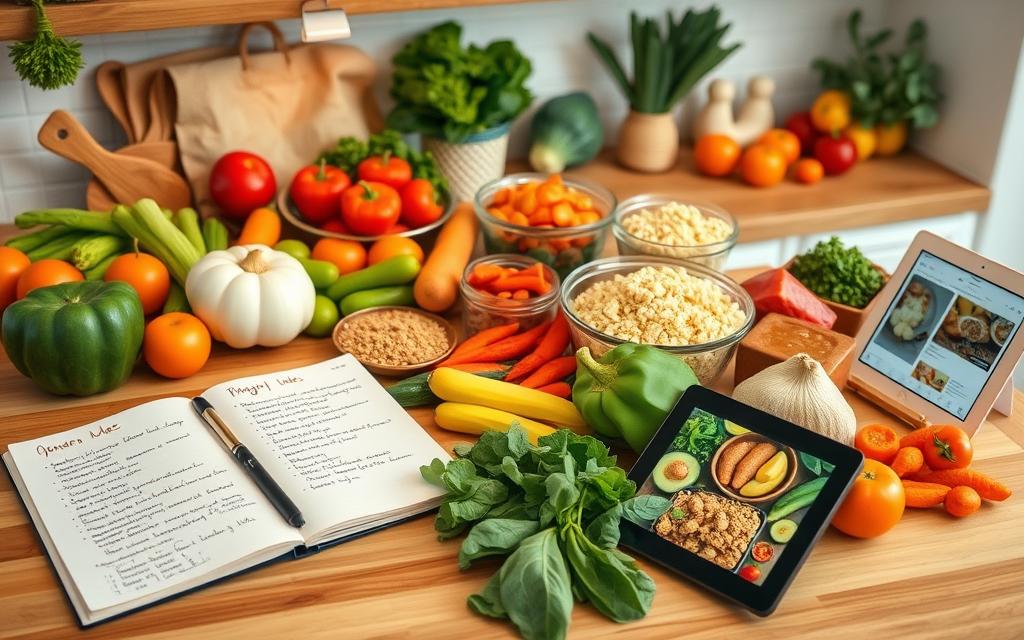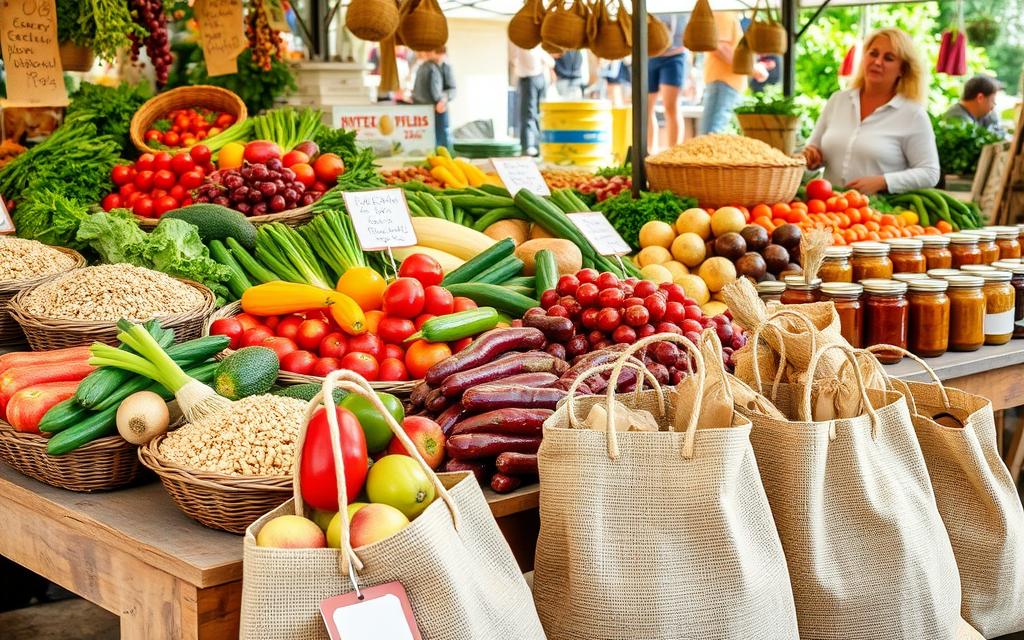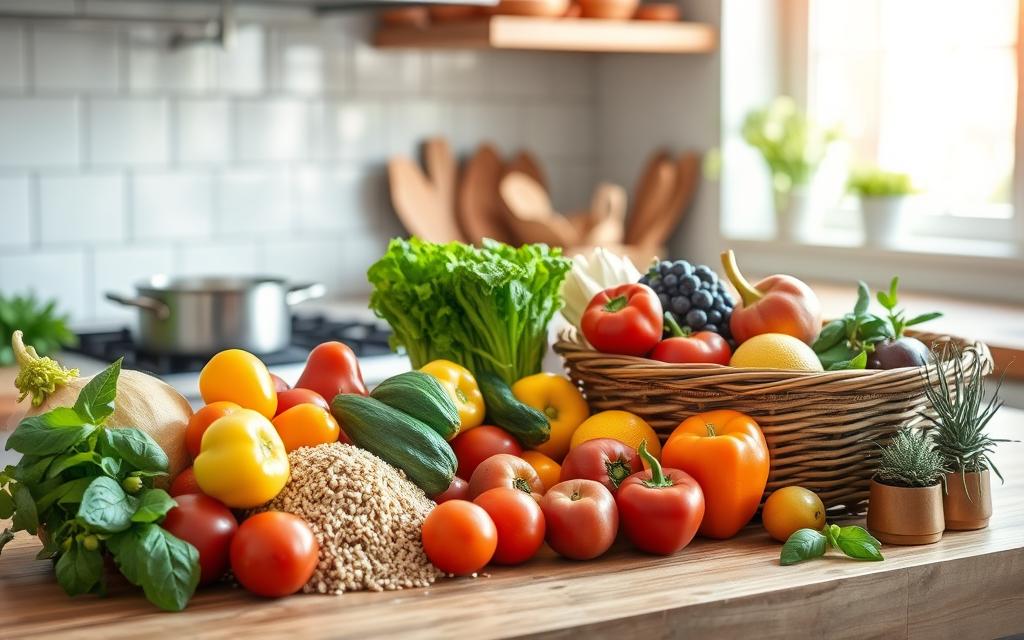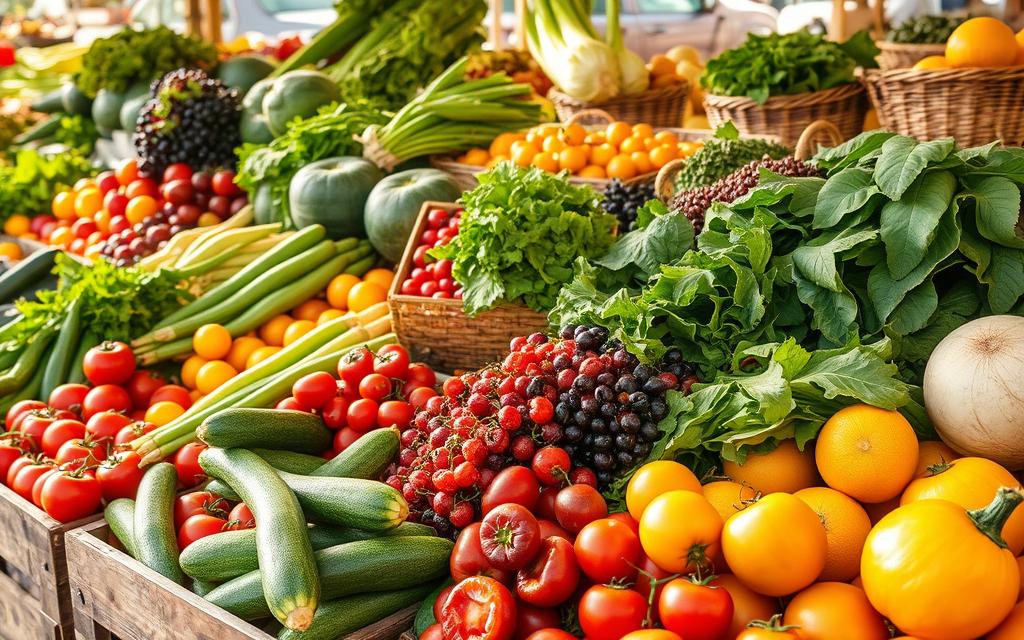We all want to eat healthy and nutritious foods, but it often seems too expensive. The idea of buying groceries that turn into fast food can be scary. Family meals can cost $20 to $30, which is a lot for just a few hours of food1. But, what if we could eat well without spending a lot?
Meal prepping helps us plan and prepare meals, sticking to our grocery lists and avoiding impulse buys2. By shopping the perimeter of grocery stores, we find more whole foods, which are often cheaper and healthier2. We can cut our grocery bills by 20%-30% by choosing whole grains and seasonal veggies2. This guide will show you how to make healthy, tasty meals without breaking the bank.
Key Takeaways
- Meal prepping reduces impulsive spending and helps stick to a grocery list.
- Shopping the perimeter of the store increases whole food purchases.
- Whole foods are often 20-30% cheaper than processed options.
- Being mindful of shopping while hungry can save up to 30% in expenses.
- Seasonal produce can save significant costs, being 20-50% cheaper than out-of-season items.
- Budget-friendly meals can be healthier and more satisfying than fast food.
Understanding the Importance of Eating Healthy
Eating well is key for our health, affecting our mind, mood, and body. Eating at least five fruits and veggies a day helps a lot. A diet rich in these can lower risks of obesity, heart disease, and diabetes.
Choosing unsaturated oils and keeping fats under 30% of our energy intake is also good.
Healthy eating boosts our mood and energy. It also helps our brain work better, which is vital for daily tasks. Eating oily fish like salmon once a week is great for our heart.
But, obesity and high cholesterol are big health risks, leading to heart disease and high blood pressure. These conditions can cause serious problems if not managed.
When money is tight, finding cheap, healthy food is important. We should aim to eat less sugar, below 10% of our total energy intake, for better health. Also, keeping salt intake under 5g daily can help lower blood pressure risk.
Every food choice we make affects our health now and in the future. It’s important to be mindful of this.
Planning Meals to Maximize Budget and Nutrition
Effective meal planning is key to saving money and eating well. By setting aside one day a week for meal prep, we can make a detailed grocery list. This helps us avoid buying things we don’t need and reduces food waste, which can be up to 30% less.
Also, meal planning can save us about 20% on grocery bills compared to buying on impulse.
Creating a Weekly Meal Plan
When planning meals for the week, aim for three meals a day and snacks. For example, a budget of £55 can cover meals for two people in the UK. Eating fruits and veggies daily and using leftovers can make our meals balanced and cost-effective.
Cooking at home can save us around $1,000 a year compared to eating out. It’s a smart way to save money.
Avoiding Impulse Buys with a Grocery List
Having a detailed grocery list helps us stick to our meal plan and avoid impulse buys. Before shopping, check what you already have at home. This way, you won’t spend extra money.
Home-cooked meals are about 50% lower in calories than restaurant food. Choosing heart-healthy foods, like unsaturated fats, makes our meals tasty and good for us.

Smart Grocery Shopping Tips for Healthy Eating
Smart grocery shopping can lead to healthier eating without breaking the bank. Start by making a list based on your meal plan. This helps avoid impulse buys and keeps you on track with your health goals7. Shopping when hungry can increase spending by up to 50%.
Buying produce in season not only saves money but also tastes better. It can be 20-40% cheaper than out-of-season produce. This makes meals more enjoyable.
Choosing “no salt added” items can cut sodium by up to 50%. Shopping the store’s perimeter for fresh foods is also wise. It’s where you find dairy, produce, and lean proteins. Frozen fruits and veggies are just as nutritious and can be 50% cheaper than fresh.

Understanding unit pricing can save 10-20% on your shopping9. Check nutrition labels to compare healthier options. Whole grains are better than refined grains because they have more fiber.
Beans and lentils are affordable protein sources, costing about $0.80 per pound. This is much cheaper than meat, which can cost $3.00 to $5.00 per pound.
By following these tips, you can avoid processed foods and make choices that support your health goals.
Buying Whole Foods: The Cost-Effective Choice
Choosing whole foods over processed items is a smart move for our health and wallet. Fresh produce and whole grains are packed with nutrients and often cheaper than processed foods. Cooking at home can save up to 50% compared to eating out, depending on what we choose. Buying whole foods in bulk and cooking at home can also save a lot of money.
Benefits of Whole Grains and Fresh Produce
Adding whole grains and fresh produce to our diet boosts our health and saves money. These foods are rich in fiber, minerals, and vitamins. They can help lower the risk of heart disease, cancer, and type 2 diabetes. Shopping at local farmers’ markets can get us fresh produce at good prices, even more so if we buy at the end of the day.
Using a shopping list can cut impulse buys by up to 30%, saving us money. Frozen fruits and vegetables are also a good choice. They’re cheaper than fresh and just as nutritious. Committing to whole food meals can cut our food costs by 15-20% each month as we get better at cooking.

How to Eat Healthy on a Budget without Processed Foods
To avoid processed foods on a tight budget, focus on whole ingredients. Meal planning is key. It helps us avoid unhealthy foods and saves money, up to 20% of grocery costs. Cooking with fresh fruits and veggies makes half our plates full of nutrients.

Whole grains like rice and oats are cheap and good for our hearts. Beans and legumes are also affordable and high in fiber, saving us 30%-50% on protein costs. Adding black beans and lentils to our meals boosts nutrition and satisfaction.
Cooking at home lets us control what we eat, saving money on dining out. Meals out can cost up to three times more. Being mindful of portion sizes helps manage calories, as restaurant portions are often too big.
Shopping for seasonal produce saves money and ensures freshness. Whole foods are 10% to 50% cheaper than processed ones, reducing sugars and unhealthy fats.
In short, making smart choices and cooking from scratch balances affordability with nutrition. This way, we avoid the unhealthy aspects of processed foods.
Shopping Seasonally and Locally for Fresh Ingredients
Shopping for seasonal produce lets us get the freshest ingredients and support local farmers. Foods in season are often cheaper because there’s more of them. They also have more vitamins, nutrients, and antioxidants, which is good for our health.
In South Carolina, over 120 farmers’ markets offer fresh crops. This makes it easy to buy directly from producers. Some markets, like the Abbeville County Farmers Market, are open all year. This means we can always find the best local produce.
- Dark green leafy vegetables are full of antioxidants and fiber, key for a healthy diet
- Yellow and orange fruits and veggies, like carrots and squash, are packed with vitamin C, A, and potassium, boosting our health
- Shopping at local farmers’ markets connects us with our community and shows us where our food comes from
CSA programs help us get more local, seasonal produce. This makes it simple for families to eat fresh. By choosing seasonal shopping, we get a variety that’s good for our health and lowers disease risk.

Incorporating Plant-Based Meals Into Your Diet
Switching to a plant-based diet is a smart choice for better nutrition and health. Legumes are a great source of affordable protein. They help us make healthy meals that are tasty and good for us. Since ancient Greece, people like Pythagoras have praised plant-based diets.
Legumes give us the protein we need, making it easy to meet our daily needs. They are also easy to make and won’t break the bank.
Affordable Protein Alternatives
Beans, lentils, and chickpeas are top choices for affordable protein. They meet our nutritional needs and are great in many recipes. Eating vegetarian can lower heart disease, diabetes, and cancer risks, making plant-based meals key to our health.
By eating enough protein, we can easily add legumes to our meals. This boosts their nutritional value.
Versatile Legume Dishes for Every Meal
Making meals with legumes is easy and delicious. From lentil soups to bean stews, these dishes save time and money. Adding whole fruits, veggies, and grains makes our meals balanced and nutritious.
It’s important to eat whole foods for better digestion and health. Cooking with family or friends makes meal prep fun. It also helps everyone enjoy the variety of plant-based meals.
| Legume Type | Protein Content (per cup) | Best Uses |
|---|---|---|
| Black Beans | 15g | Salads, tacos, soups |
| Lentils | 18g | Soups, stews, curries |
| Chickpeas | 14g | Salads, hummus, stews |
| Kidney Beans | 15g | Chili, salads, side dishes |
Adding legumes to our meals makes our diet richer and healthier. Starting a plant-based diet can greatly improve our health and well-being18.
Buying in Bulk: A Key Strategy for Savings
Buying in bulk is a smart way to save money on groceries. It offers healthy options and cuts down our bills. For example, a case of 10 cans of diced tomatoes costs $11, down from $20 for the same amount. This shows how buying in bulk can save us money.
Items like grains, dried beans, and pasta last a long time. This makes them perfect for storing in bulk. By buying in bulk, we can eat healthy and save cash at the same time.
Recommended Bulk Items for a Nutritious Diet
Choosing the right items to buy in bulk is key. Here are some top picks:
- Grains (such as rice and quinoa)
- Canned goods (like beans and vegetables)
- Pasta and whole grain options
- Nuts and seeds for healthy snacks
- Frozen fruits and vegetables
- Oils, like extra-virgin olive oil
For example, a 5-pound bag of quinoa costs about $30, compared to $8 for 1 pound. This shows how buying in bulk can lower our costs per unit. These items not only boost our nutrition but also help us save up to 15% on our grocery bills each month.
How to Store Bulk Purchases Properly
Storing bulk items right is important. It keeps them fresh and extends their shelf life. Here’s how:
- Use airtight containers for grains and cereals to prevent staleness.
- Store nuts and seeds in the freezer to maintain freshness and avoid rancidity.
- Keep canned goods in a cool, dark place, as they can last several years.
- Store hard cheeses like Parmesan in the freezer for up to six months.
- Bought in bulk, eggs and butter can last well past their expiration dates when stored correctly.
By following these storage tips, we can enjoy the benefits of bulk buying. It helps us keep our food fresh and safe while sticking to our budget. Bulk food storage is a great way to eat well and save money.
The Benefits of Frozen and Canned Foods in Your Diet
Adding frozen and canned foods to our meals can be a budget-friendly and nutritious choice. Frozen fruits and veggies are often picked and frozen quickly, keeping their nutrients intact21. This way, we can enjoy their health benefits all year without worrying about them going bad. Canned foods, while processed more, still offer a good way to get essential nutrients21.
When we plan our meal prep, it’s best to choose canned foods without added sugars or salt. Canned items often have a lot of sodium to hide taste changes. Look for ones with no salt added, which have less than 5 mg of sodium22. Some canned fruits come in their own juice or water, which means less added sugar.
Having a balanced diet with lots of fruits and veggies is key for a strong immune system, no matter if they’re canned, frozen, or fresh. For those facing grocery store challenges, nutritionists say frozen foods are better than canned. Freezing blanches produce first, which helps keep its nutrients similar to fresh.
The table below shows the main differences between frozen and canned foods:
| Type | Processing Steps | Nutritional Retention | Convenience | Shelf Life |
|---|---|---|---|---|
| Frozen Foods | Blanching, Freezing | High retention of nutrients | Requires cooking, but simple to prepare | Lasts longer than fresh |
| Canned Foods | Processing, Sealing, Heating | Often less nutritional value; watch for added sodium | Ready to eat, but may require rinsing | Has a long shelf life |
Knowing the benefits of frozen and canned foods helps us make better choices. This way, we can improve our meals, stay healthy, and save money.
Using Coupons and Discounts Efficiently
We can make our money go further by using couponing and healthy food discounts. By smartly using these tools, we can spend less and still eat well. Learning to find great deals helps us save a lot on groceries.
Finding Valuable Deals on Healthy Food
Creating a meal plan and shopping list can save us up to 30% on groceries. Digital coupons, used by over 90% of shoppers, are key in this effort. Using these coupons with sales can cut our grocery bills by 10-20%.
Shopping at farmers’ markets can save us 20-50% on fresh produce. Vendors often give discounts to clear out stock. CSA programs also offer savings of 10-25% on quality produce.
Stocking Up During Sales
Stocking up on non-perishables during sales is another smart move. Buying in bulk can save us 10-50% on items like grains and oils. Cooking large batches can cut food costs by 20-25% and reduce waste by over 50% if stored right.
Loyalty programs can add up to 10% in savings when paired with coupons. By using these tactics, we can shop smartly and stay within our budget while focusing on quality and health.
Creative Cooking Techniques to Enhance Flavor
Exploring new cooking methods can make our meals flavorful without breaking the bank. Using herbs and spices brings out the best in our food, making every bite tasty. Home cooks often don’t season enough, which can make food less tasty.
Experts say to season in stages for better flavor. Sea salt, like Jacobsen Salt Co., adds depth and minerals to food25.
Using Herbs and Spices for Flavor Boosts
Adding fresh herbs at the end keeps their flavor and nutrients. Dried herbs like oregano, basil, or thyme can make simple dishes taste better without costing much. Natural acids like citrus and vinegar can also cut down on calories while keeping flavors rich.
Ingredients like garlic, onion, and fresh herbs can help reduce the need for unhealthy fats and condiments.
Batch Cooking to Save Time and Money
Batch cooking lets us make meals in large amounts, saving time and money. Slow cooking makes food tender and flavorful, even with cheaper cuts of meat26. We can freeze leftovers for future meals, avoiding expensive takeout.
Grilling adds a smoky taste to our dishes, making them more interesting without expensive ingredients. This way, we can enjoy healthy, varied meals while exploring different cooking techniques.
Mindful Eating: Enjoying Your Meals on a Budget
Mindful eating helps us enjoy our meals more. It makes digestion better and satisfaction higher. Sharing meals with family or friends turns eating into a fun event.
This shared joy makes healthy food more appealing. It also strengthens our bonds with others.
Making Mealtime a Social Experience
Eating together brings us closer to each other. It helps us stick to healthy eating, even when money is tight. Mindful eating during meals is possible, even on a budget.
It’s about being kind and flexible with our food choices. Around 80% of mindful eaters feel more connected to their food.
Meal-prepping and sharing recipes makes cooking fun. It saves money and increases our appreciation for food. Eating nutrient-rich foods like beans and canned veggies is affordable and healthy.
Even with tight budgets, finding joy in eating is key. It helps our mental health. Enjoying smaller portions of our favorites makes us happier with our meals30.
Conclusion
Eating healthy on a budget is definitely possible. We’ve looked at ways to get more nutrition without losing flavor. This includes planning meals and choosing the right groceries.
Choosing whole foods and seasonal items helps us save money and eat well. Adding plant-based meals to our diet is also a smart move. It lets us enjoy tasty food while taking care of our health and wallets.
Studies show that eating lots of fruits, veggies, and whole grains helps with weight control. It also lowers the risk of heart disease and diabetes31. Plus, eating right can make us feel better mentally.
With a little planning and creativity, we can start a healthy lifestyle. Making smart food choices and watching our spending helps us enjoy many delicious meals. This way, we improve our health and save money, setting a good path for the future.
FAQ
How can we eat healthy on a budget?
Eating healthy on a budget is easy. Plan your meals, shop smart, and cook from scratch. Use whole foods and seasonal produce. A plant-based diet and nutritious choices help you enjoy healthy meals without spending too much.
What are some tips for meal planning?
Set aside one day a week for meal prep. Make a grocery list based on your meal plan. Check what you already have at home to avoid buying duplicates. This helps you avoid impulse buys and saves money.
Why is shopping for whole foods cost-effective?
Whole foods like grains, fruits, and veggies are cheaper and healthier. They offer more nutrients than processed foods. This way, you get better taste and more servings for less money.
What should we look for when buying seasonal produce?
Buying seasonal produce boosts flavor and nutrition and is often cheaper. Shopping at local farmers’ markets can save money and support local farmers.
How do we incorporate plant-based meals into our diet effectively?
Include legumes like beans and lentils for affordable, nutritious protein. They’re great for many dishes, making it easy to eat well on a budget.
What strategies can help us save money on grocery shopping?
Save by buying in bulk, using coupons, and watching for sales. Focus on discounts for whole foods to stock up on healthy items when they’re cheaper.
How do frozen and canned foods fit into a healthy diet?
Frozen and canned foods are good substitutes for fresh produce. They’re often just as nutritious. Choose options without added sugars or preservatives for better value and to prevent waste.
What cooking techniques can enhance flavor without extra cost?
Use herbs and spices to boost flavor without spending more. Batch cooking saves time and money, ensuring healthy meals are always ready.
How can we practice mindful eating on a budget?
Mindful eating makes meals more enjoyable, improving digestion and satisfaction. Sharing meals with family or friends adds to the experience, making healthy eating more enjoyable.
